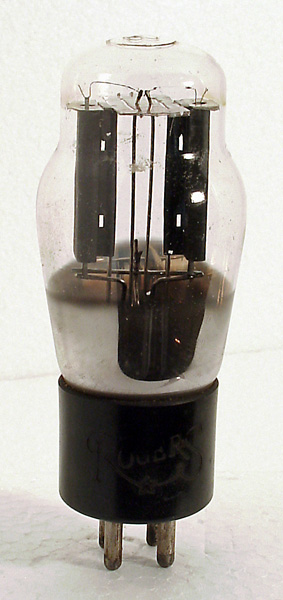|
80Sensibly equivalent¶ to:
|
|
|

|
It would be correct to say that the type 80 led standard practice since in its earlier, more bulbous form, it was the landmark full-wave rectifier and (we think) the first mass-produced rectifier to use oxide-coated tape filaments.Consider the ratings of the type 80. Put a B4 base on it and drop its filament voltage slightly and it becomes the standard pre-war British/European rectifier for all types of domestic AC radio. Put an octal base on and it becomes the standard 1940s rectifier throughout the world. Replace the tape filaments by heater/cathode assemblies (80S) and you have the international bog-standard post-war rectifier. Only where much higher ratings, or much smaller size, were essential was it necessary to change the design. It took a decade to design miniature equivalents which worked as well or lasted as long.This is not to say that the type 80 was easy to design or, at first, easy to manufacture satisfactorily. When introduced by RCA in the late 1920s its PIV rating (1000V) was considered impossibly high for an oxide-coated valve. Part of the secret was a really good vacuum and this in turn depended on the elimination of contaminants by using only high-purity materials and clean-room assembly techniques. Widely copied by other manufacturers, surviving early specimens often exhibit arc-damaged electrodes, flaking oxide coatings and poor emission. Manufacturers who surmounted the 'learning curve' with type 80 went on to become 'big names' in the 1930s and 1940s. The rest simply faded.The maximum reservoir capacitor is 32 µF and the minimum series resistance, to limit current, is 30 Ohms.The classic envelope is 42 mm in diameter and, excluding the UX4 base pins, is 99 mm tall.References: Data-sheet, private communication, 1040 & 1043. Type 80 was first introduced in 1936. See also 1936 adverts. |
Pin Connections
| 1 | 2 | 3 | 4 |  f+ | a(2) | a(1) | f- |
|
|
Absolute Maximum Operating Conditions¶
| Vh | Ah | Va | mAa | 
| 5.0 | 2.0 | 350 | 125 |
|
Updated April 04, 2013.
|
|